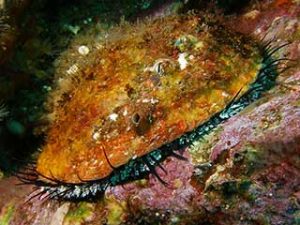Marine Reserves Enhance Resilience to Climatic Impacts – Isla Natividad, Mexico

Pink Abalone. Photo copyright Tom Reamy
Scientists at Stanford University have found that marine reserves can actually aid in ecosystem recovery- allowing an area to bounce back following environmental disasters. A recent study of abalone shows that marine reserves can jumpstart the recovery of nearby fishing areas, even after natural environmental changes stress the system.
In 2006, in response to continued declines in abalone catches in the Gulf of California, the local fishing cooperative of Isla Natividad voluntarily established two marine reserves, where the take of all marine life was prohibited. Here, fishermen protected 8% of all fishing grounds surrounding the island from harvest pressures. Two years in a row, the area was hit hard by hypoxic events, which occurs when levels of oxygen in the water column dip. These episodes of low dissolved oxygen can weaken and kill marine life, causing widespread mortality of abalone.
The Stanford study found that while abalone populations dropped both inside and outside reserves in response to the hypoxic events, the declines were significantly less inside the reserves compared to the fished area. Perhaps more importantly, abalone were much larger and produced many more eggs inside the reserves compared to fished areas. Inside the reserves, the rate that abalone grew to become large enough to be harvested was 9 times higher than in fished areas. Both the large size and the higher density of abalone inside the reserves are thought to be key to the resilience of abalone populations inside the protected areas. These results show how marine reserves are vital to jumpstart the recovery of a species (such as abalone) following a steep decline, even when those declines occur due to natural events.
The hypoxic events that are impacting abalone populations are relatively new developments along the western coast of North America. Oxygen Minimum Zones appear to be expanding, setting the stage for future hypoxic events. This, combined with other environmental impacts such as an increase in mean ocean temperatures, lends scientific support to recommendations for the establishment of networks of marine protected areas to help offset environmental impacts. These findings suggest that management actions aimed at alleviating local stressors, such as protection in marine reserves, can also provide resilience to climatic impacts through greater resistance and faster recovery of protected populations and spillover to adjacent areas outside of the reserve.
To read more:
- http://news.stanford.edu/news/2012/july/helping-abalone-recover-071912.html
- Micheli F, Saenz-Arroyo A, Greenley A, Vazquez L, Espinoza Montes JA, et al. (2012) Evidence That Marine Reserves Enhance Resilience to Climatic Impacts. PLoS ONE 7(7): e40832. doi:10.1371/journal.pone.0040832
- Abstract: http://www.plosone.org/article/info:doi/10.1371/journal.pone.0040832
- Full Paper (366K PDF file)


